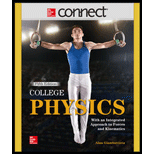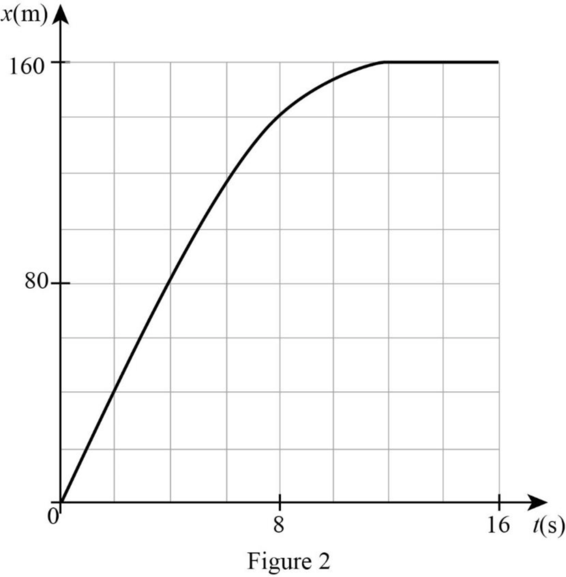
Concept explainers
The distance travelled by the car between
Answer to Problem 23P
The distance travelled by the car between
Explanation of Solution

Write the expression for the displacement from the velocity-time graph.
Write the expression for the area under the graph.
Write the expression for the area of rectangle ABCD.
Here,
Write the expression for the area of the triangle CDE
Here,
Use equation (III) and (IV) in (II) to solve for distance travelled by the car.
Write the expression for the distance travelled by an object.
Use equation (VI) and (V) to solve for the position of the car at
Similarly, the distance travelled by the car at

Figure

Figure
Conclusion:
Substitute
Therefore, the distance travelled by the car between
Want to see more full solutions like this?
Chapter 3 Solutions
COLLEGE PHYSICS-CONNECT ACCESS
- 8.69 Spheres A (mass 0.020 kg), B (mass 0.030 kg), and C (mass 0.050 kg) are approaching the origin as they slide on a frictionless air table. The initial velocities of A and B are given in Fig. P8.69. All three spheres arrive at the origin at the same time and stick together. (a) What must the x- and y-components of the initial velocity of C be if all three objects are to end up moving at 0.50 m/s in the +x-direction after the col- lision? (b) If C has the velocity found in part (a), what is the change in the kinetic energy of the system of three spheres as a result of the collision? Figure P8.69 UC C B UB=0.50 m/s 60° VA = 1.50 m/s Aarrow_forward8.36 A 1050 kg sports car is moving westbound at 15.0 m/s on a level road when it collides with a 6320 kg truck driving east on the same road at 10.0 m/s. The two vehicles remain locked together after the collision. (a) What is the velocity (magnitude and direction) of the two vehicles just after the collision? (b) At what speed should the truck have been moving so that both it and the car are stopped in the collision? (c) Find the change in kinetic energy of the system of two vehicles for the situ- ations of parts (a) and (b). For which situation is the change in kinetic energy greater in magnitude?arrow_forward8.10 ⚫ A bat strikes a 0.145 kg baseball. Just before impact, the ball is traveling horizontally to the right at 40.0 m/s; when it leaves the bat, the ball is traveling to the left at an angle of 30° above horizontal with a speed of 52.0 m/s. If the ball and bat are in contact for 1.75 ms, find the horizontal and vertical components of the average force on the ball.arrow_forward
- a 500-n block is dragged along a horizontal surface by an applied force t at an angle of 30.0° (see figure). the coefficient of kinetic friction is uk = 0.400 and the block moves at a constant velocity. what is the magnitude of the applied force T in newtons?arrow_forwarda 500-n block is dragged along a horizontal surface by an applied force t at an angle of 30.0° (see figure). the coefficient of kinetic friction is uk = 0.400 and the block moves at a constant velocity. what is the magnitude of the applied force T in newtons?arrow_forwardBlock A, with a mass of 10 kg, rests on a 30° incline. The coefficient of kinetic friction is 0.20. The attached string is parallel to the incline and passes over a massless, frictionless pulley at the top. Block B, with a mass of 15.0 kg. is attached to the dangling end of the string. What is the acceleration of Block B in m/s? show all steps pleasearrow_forward
- When current is flowing through the coil, the direction of the torque can be thought of in two ways. Either as the result of the forces on current carrying wires, or as a magnetic dipole moment trying to line up with an external field (e.g. like a compass). Note: the magnetic moment of a coil points in the direction of the coil's magnetic field at the center of the coil. d) Forces: We can consider the left-most piece of the loop (labeled ○) as a short segment of straight wire carrying current directly out of the page at us. Similarly, we can consider the right-most piece of the loop (labeled ) as a short segment straight wire carrying current directly into the page, away from us. Add to the picture below the two forces due to the external magnetic field acting on these two segments. Then describe how these two forces give a torque and determine if the torque acts to rotate the loop clockwise or counterclockwise according to this picture? Barrow_forwardIn each of the following, solve the problem stated. Express your answers in three significant figures. No unit is considered incorrect. 1. For the circuit shown, determine all the currents in each branch using Kirchhoff's Laws. (3 points) 6 5V 2 B C 4 A www 6 VT ww T10 V F E 2. Compute for the total power dissipation of the circuit in previous item. (1 point) 3. Use Maxwell's Mesh to find Ix and VAB for the circuit shown. (3 points) Ix 50 V 20 ww 21x B 4. Calculate all the currents in each branch using Maxwell's Mesh for the circuit shown. (3 points) www 5ი 10 24V 2A 2002 36Varrow_forwardIf the mass of substance (1 kg), initial temperature (125˚C), the final temperature (175˚C) and the total volume of a closed container (1 m3) remains constant in two experiments, but one experiment is done with water ( ) and the other is done with nitrogen ( ). What is the difference in the change in pressure between water and nitrogen?arrow_forward
 College PhysicsPhysicsISBN:9781305952300Author:Raymond A. Serway, Chris VuillePublisher:Cengage Learning
College PhysicsPhysicsISBN:9781305952300Author:Raymond A. Serway, Chris VuillePublisher:Cengage Learning University Physics (14th Edition)PhysicsISBN:9780133969290Author:Hugh D. Young, Roger A. FreedmanPublisher:PEARSON
University Physics (14th Edition)PhysicsISBN:9780133969290Author:Hugh D. Young, Roger A. FreedmanPublisher:PEARSON Introduction To Quantum MechanicsPhysicsISBN:9781107189638Author:Griffiths, David J., Schroeter, Darrell F.Publisher:Cambridge University Press
Introduction To Quantum MechanicsPhysicsISBN:9781107189638Author:Griffiths, David J., Schroeter, Darrell F.Publisher:Cambridge University Press Physics for Scientists and EngineersPhysicsISBN:9781337553278Author:Raymond A. Serway, John W. JewettPublisher:Cengage Learning
Physics for Scientists and EngineersPhysicsISBN:9781337553278Author:Raymond A. Serway, John W. JewettPublisher:Cengage Learning Lecture- Tutorials for Introductory AstronomyPhysicsISBN:9780321820464Author:Edward E. Prather, Tim P. Slater, Jeff P. Adams, Gina BrissendenPublisher:Addison-Wesley
Lecture- Tutorials for Introductory AstronomyPhysicsISBN:9780321820464Author:Edward E. Prather, Tim P. Slater, Jeff P. Adams, Gina BrissendenPublisher:Addison-Wesley College Physics: A Strategic Approach (4th Editio...PhysicsISBN:9780134609034Author:Randall D. Knight (Professor Emeritus), Brian Jones, Stuart FieldPublisher:PEARSON
College Physics: A Strategic Approach (4th Editio...PhysicsISBN:9780134609034Author:Randall D. Knight (Professor Emeritus), Brian Jones, Stuart FieldPublisher:PEARSON





